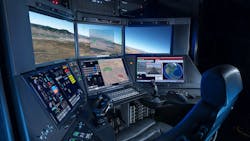General Atomics eyes detect-and-avoid radar and algorithms to enable unmanned MQ-9A to fly in civil airspace
PATUXENT RIVER NAS, Md. – U.S. Navy unmanned aerial vehicle (UAV) experts needed a detect-and-avoid system to enable the U.S. Marine Corps MQ-9A Reaper attack UAV to fly safely near other crewed and uncrewed aircraft. They found their solution from General Atomics Aeronautical Systems Inc. in Poway, Calif.
Officials of the Naval Air Systems Command at Patuxent River Naval Air Station, Md., announced a $30.9 million order to General Atomics this week to develop and certify the MQ-9A Detect and Avoid System for the Marine Corps.
This detect-and-avoid system will enable the Marine Corps MQ-9A to meet the "see and avoid" requirements of flying in controlled U.S. airspace. It is an alternative means of compliance, known as detect and avoid.
The General Atomics detect-and-avoid system for the Reaper UAV uses the company's air-to-air radar (ATAR) and a detect-and-avoid software algorithm. The certified detect-and-avoid system, began in 2018, uses a Traffic Collision Avoidance System (TCAS) II, and meets the "see and avoid" requirements in the United States and eventually in Europe.
The latest General Atomics detect-and-avoid radar is called the Due Regard Radar (DRR) to fly in international airspace. The radar has a two-panel active electronically scanned array (AESA) antenna and a radar electronics assembly (REA) that enables the Reaper's remote pilot to detect and track aircraft.
The AESA radar can track several targets at once while scanning scan for new aircraft. The detect-and-avoid system for the Reaper UAV has an air-cooled antenna and radar electronics; can detect and track within its field of view; enables due regard operations in international airspace; and helps integrate the Reaper UAV into U.S. civil controlled airspace.
On this order General Atomics will do the work in Poway, Calif., and at Patuxent River NAS, Md., and should be finished by April 2026. For more information contact General Atomics Aeronautical Systems online at www.ga-asi.com, or Naval Air Systems Command at www.navair.navy.mil.
